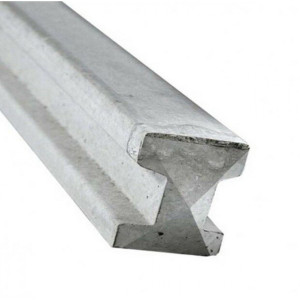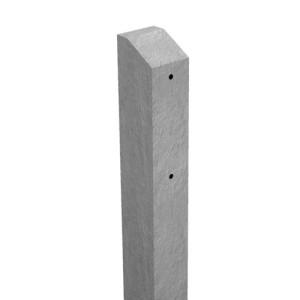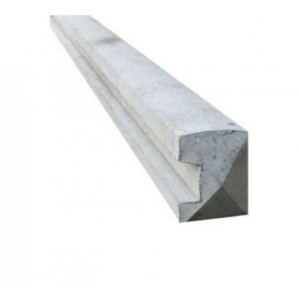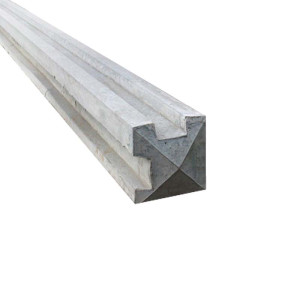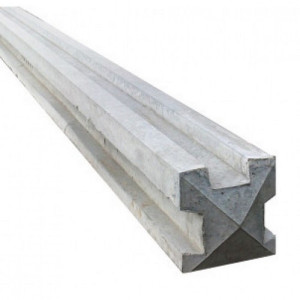Your Cart
x
Concrete Fence Posts
Explore our selection of concrete fence posts, the foundation for a strong, durable, and maintenance-free fencing solution. Designed to enhance the longevity of your garden border, these posts provide unparalleled support and stability to our high-quality, pressure-treated fence panels.
Resistant to rot, decay, and termite damage, they are built to withstand the harshest weather conditions, ensuring your fencing remains intact and pristine year after year. Ideal for those seeking a robust and reliable fencing structure without compromising on aesthetics, our concrete fence posts promise enduring performance and a sleek finish to your outdoor space.
Our 8FT Concrete Intermediate Fence Post (2.4M) is a top-quality product, designed to provide a strong and durable support for your fence panels. Made from high-quality wet cast concrete and reinforced with steel, these concrete posts can withstand harsh weather conditions and long-term use without ..
£29.95 £34.95
Ex Tax:£24.96Introducing our 6FT Concrete Intermediate Fence Post (1.8M) - a sturdy and reliable option for your fencing needs. This post is constructed using wet cast concrete, which results in a consistently smooth and durable finish. Steel reinforcement adds extra strength and stability, making it suitable fo..
£28.95 £31.95
Ex Tax:£24.13Our 7FT Concrete Intermediate Fence Post (2.1M) is the perfect solution for those who are looking for a sturdy and durable concrete posts. Made with wet cast concrete and steel reinforcement, these posts are built to withstand the toughest weather conditions. Whether you are protecting your garden, ..
£29.95 £32.95
Ex Tax:£24.96Like all of our concrete products, this concrete repair spur is wet cast and steel reinforced. Repair spurs are a cost effective way of repairing a broken wooden fence posts without changing the post.Bolts not included..
£22.95
Ex Tax:£19.13Our 7ft concrete end posts, which are the neatest way to finish the end of a fencing run, are a wet cast steel reinforced concrete fence post.The wet-cast 7ft concrete end fence post does not have a nib or peg in the slot to support your gravel board and/ or fence panel. Our concrete posts are suita..
£41.95
Ex Tax:£34.96Our 8FT Concrete Corner Fence Post (2.4M), which are the neatest way to finish a fence on a right angle, are a wet cast steel reinforced concrete fence post.Our wet-cast 8FT Concrete Corner Fence Post (2.4M) post does not have a nib or peg in the slot to support your gravel board and/ or f..
£43.95
Ex Tax:£36.63Our 7FT Concrete Corner Fence Post (2.1M), which are the neatest way to finish a fence on a right angle, are a wet cast steel reinforced concrete fence post.Our wet-cast 7FT Concrete Corner Fence Post (2.1M) post does not have a nib or peg in the slot to support your gravel board and/ or f..
£41.95
Ex Tax:£34.96Our 6ft concrete end posts, which are the neatest way to finish the end of a fencing run, are a wet cast steel reinforced concrete fence post.The wet-cast 6ft concrete end fence post does not have a nib or peg in the slot to support your gravel board and/ or fence panel. Our concrete posts are suita..
£41.95
Ex Tax:£34.96Our 8FT Concrete 3-Way Fence Post (2.4M), which are the neatest way to finish a fence on a right angle, are a wet cast steel reinforced concrete fence post.Our wet-cast 8FT Concrete 3-Way Fence Post (2.4M) post does not have a nib or peg in the slot to support your gravel board and/ or fen..
£43.95
Ex Tax:£36.63Our 9ft Concrete Intermediate Fence Post (2.7m) is a sturdy and reliable option for those looking to invest in a long-lasting fence. Made from wet cast concrete and reinforced with steel, this post is designed to withstand the elements and provide a secure foundation for your fence. Measuring in at ..
£32.95 £38.95
Ex Tax:£27.46Like all of our concrete products, this concrete repair spur is wet cast and steel reinforced. Repair spurs are a cost effective way of repairing a broken wooden fence posts without changing the post.Bolts not included..
£25.95
Ex Tax:£21.63Our 5FT Concrete Intermediate Fence Post (1.5M) is a reliable and durable solution to your fencing needs. Constructed using the wet cast method and steel reinforcement, these concrete posts withstand even the harshest of weather conditions. Its sturdy build provides excellent support for your fence ..
£26.95 £29.95
Ex Tax:£22.46
